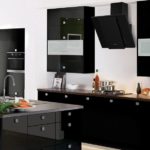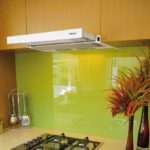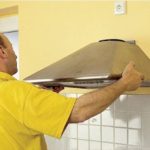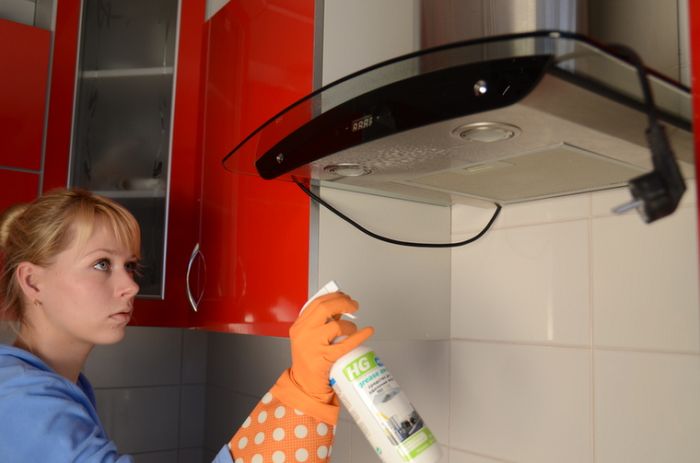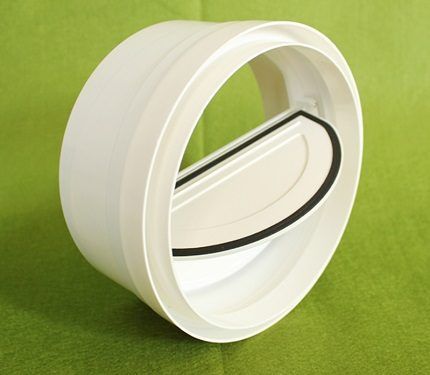How to hide a pipe from a kitchen hood
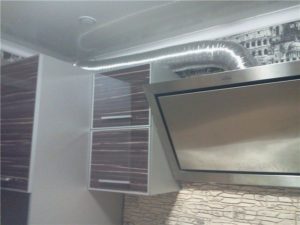 In a modern kitchen, the unspoken standard is the presence of a hood. Its role is to clean the surrounding air from substances formed during cooking. Thus, the hood ensures a comfortable stay in the room. When installing this kitchen unit, you may encounter problems with the placement of both the air duct and the hood itself. To solve this issue, there are many options for masking the air duct so that it does not spoil the interior.
In a modern kitchen, the unspoken standard is the presence of a hood. Its role is to clean the surrounding air from substances formed during cooking. Thus, the hood ensures a comfortable stay in the room. When installing this kitchen unit, you may encounter problems with the placement of both the air duct and the hood itself. To solve this issue, there are many options for masking the air duct so that it does not spoil the interior.
The content of the article
Why do you need to hide the pipe from the hood?
In total, 2 types of hoods are used - circulation and flow. A characteristic feature of circulation ones is that they pass air through filters installed inside, which must be changed periodically. They are expensive and therefore buyers are more willing to choose another type of kitchen appliance.
Flow hoods, being a fairly budget option, provide high efficiency in processing ambient air. They are often chosen by buyers for whom savings are important. The peculiarity of this type of hoods is that they are connected directly to the ventilation through an air duct.Due to the fact that the shaft itself, as a rule, is located at a considerable distance from the hood, there is a need to hide the hose that will stretch along the wall. There are several ways to solve this problem.
REFERENCE! Using a hood is not enough to completely clean the air. Be sure to ventilate the room 2 times a day.
Ways to hide a pipe from a hood
The exhaust arm, as a rule, is large in size, thereby affecting the aesthetics of the interior. It is difficult to install it so that it does not catch the eye and does not disrupt the design of the kitchen. In order to disguise this element, owners choose different methods.
Construction of a plastic box
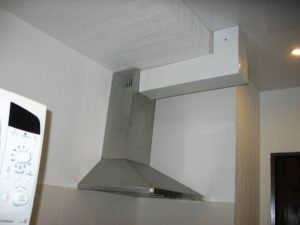 The boxes have round, square or rectangular shapes.
The boxes have round, square or rectangular shapes.
The plastic version of the box has a number of advantages unique to it:
- low price category;
- long service life;
- ease of installation and maintenance;
- almost complete silence;
- hygiene.
Over time, the box will change color, but if the air duct is correctly located behind the furniture, this aesthetic flaw will not play any role. This type of camouflage is optimal when the hood and ventilation shaft are located close together.
IMPORTANT! Most professionals recommend caulking joints to increase strength. But this can make it difficult to clean the inside of the box, especially one with a lot of bends. Therefore, you should not seal them if the structure is small in length and has additional support in the form of a cabinet roof or something else.
The plastic box can be easily installed even at home, assembled according to the “socket-pipe” principle. Many connecting elements will solve the problem of a large number of corners and obstacles in the kitchen. If necessary, you can manually adjust the pipes, because plastic is easy to saw.
To fully assemble the box you must have:
- main pipes;
- adapters;
- knee;
- connectors;
- anti-return valve;
- grate.
With the help of the listed elements, there will be no problems in assembling a structure of any length.
Disguise under a suspended or suspended ceiling
Very often, when the question of masking an air duct arises, installers recommend hiding the element under a suspended or suspended ceiling. The pipe, with this type of camouflage, is not visible at all, but in case of damage it will have to be completely disassembled. There is also a minimum ceiling height limitation. So, if the ceiling height in the kitchen is less than 2.6 m, then it will not be possible to hide the box.
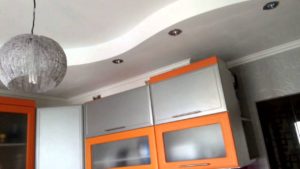
Construction of a plasterboard box
The most economical type of masking of an air duct is a box assembled from plasterboard sheets. This material fits perfectly into any interior. This design does not have any special installation difficulties and does not require large financial expenditures.
Due to the peculiarities of its structure, it cannot serve as an air duct, so drywall serves as a decor covering the corrugation.
IMPORTANT! Drywall must be waterproof so as not to collapse under the influence of the humid microclimate of the kitchen.
The main advantages of a plasterboard box are:
- variety in the choice of form;
- Possibility of choice of final finishing;
- low cost.
How to close the corrugation from the hood in the kitchen by building a channel through the furniture
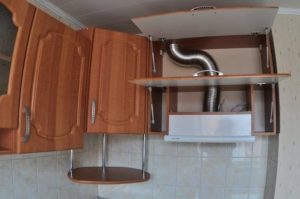 Another way to hide the corrugation is to embed it in the cavity of a wall cabinet. The advantage of this method of disguise is the ability to preserve the original interior of the kitchen and increase the functionality of the furniture by using its free space. To achieve these goals, it is recommended to design custom-made furniture so that the design already includes the possibility of hiding the corrugation. A plus will be the ability to easily dismantle and replace pipes if necessary.
Another way to hide the corrugation is to embed it in the cavity of a wall cabinet. The advantage of this method of disguise is the ability to preserve the original interior of the kitchen and increase the functionality of the furniture by using its free space. To achieve these goals, it is recommended to design custom-made furniture so that the design already includes the possibility of hiding the corrugation. A plus will be the ability to easily dismantle and replace pipes if necessary.
To successfully install the hood and its air duct into the cabinet, do the following:
- construct a valve from aluminum to prevent air from entering the room from the ventilation;
- make a hole for it on the top of the cabinet, place the valve in this place, subsequently attaching it using assembly adhesive;
- remove the element of the kitchen unit and, using a jigsaw, cut a hole in its bottom, focusing on the dimensions of the hood;
- remove the shelves and cut holes in them for the air duct;
- make a hole in the top shelf for the valve, leaving an allowance on each side of 3 mm;
- place the piece of furniture on the back wall and insert the corrugation;
- form the upper edge of the corrugation into a square in order to insert it into the hole;
- cut the inserted edge of the corrugation along the edges and bend it;
- install the cabinet in place and insert the valve into the ventilation.
Finally, install the hood into the hole cut out in the bottom of the cabinet, securing it with screws. The corrugation is put on the pipe and secured with a clamp.

